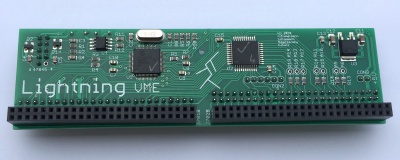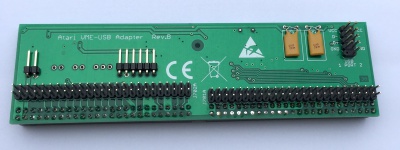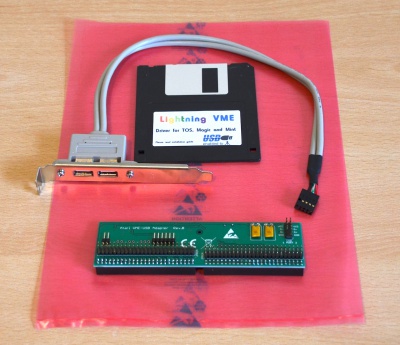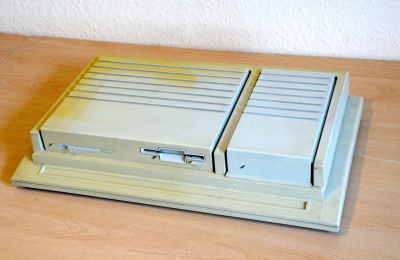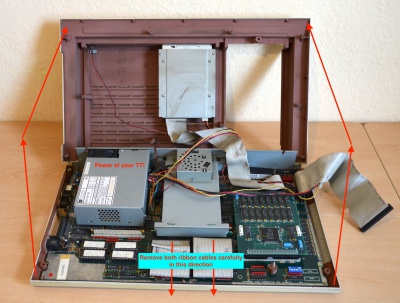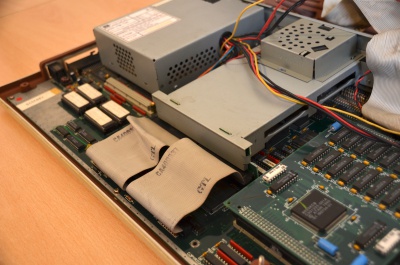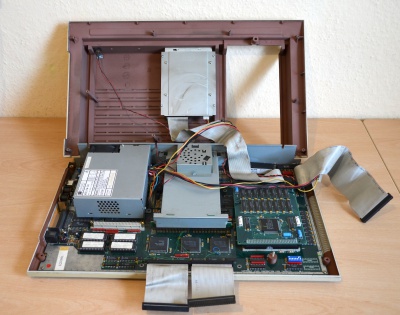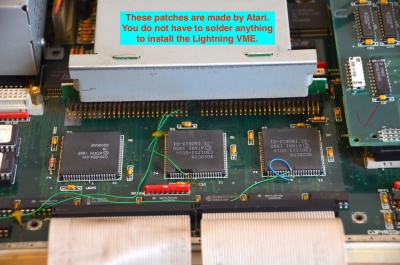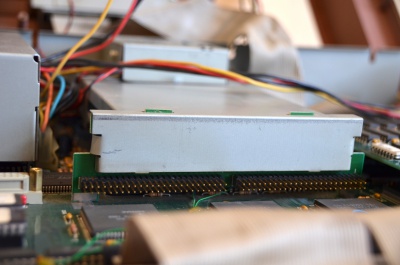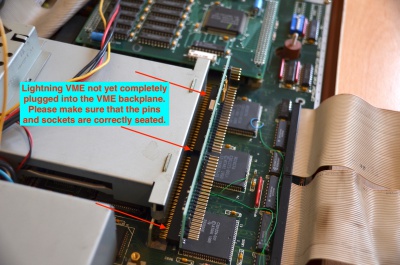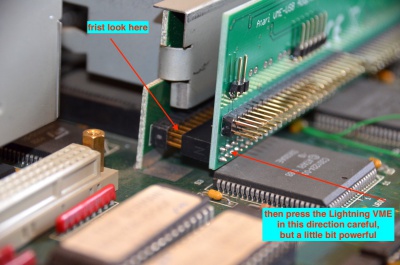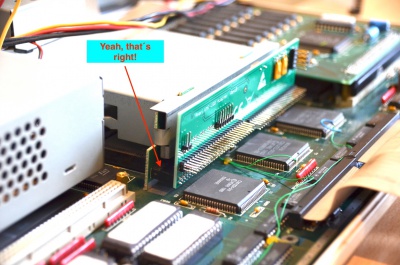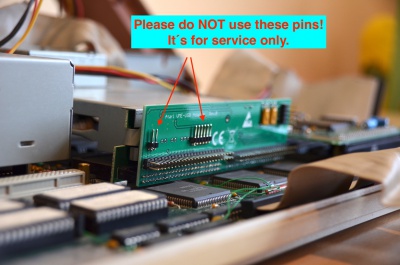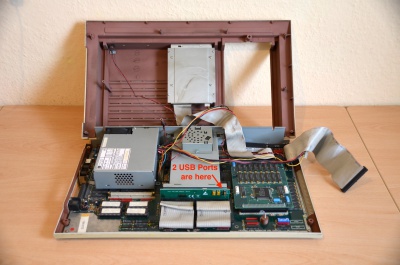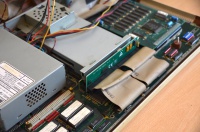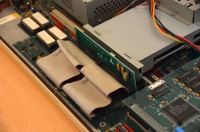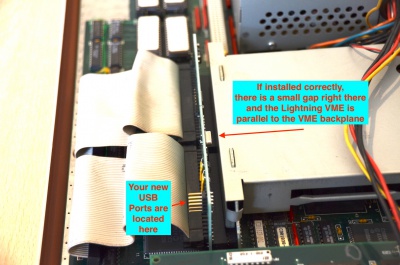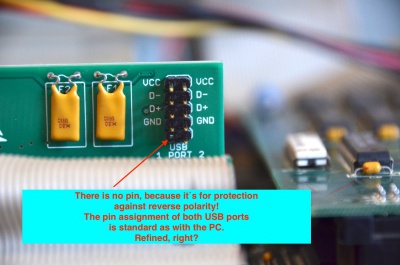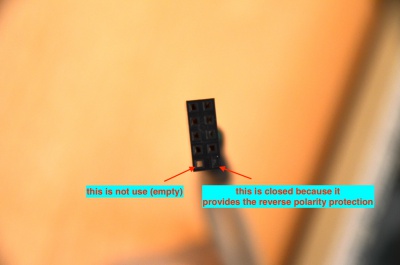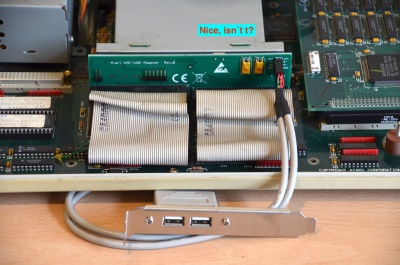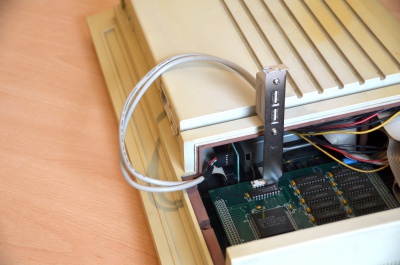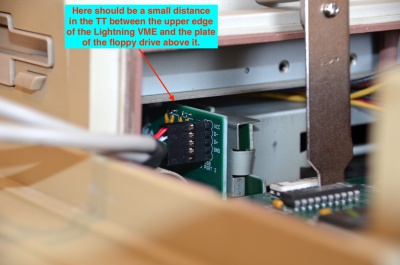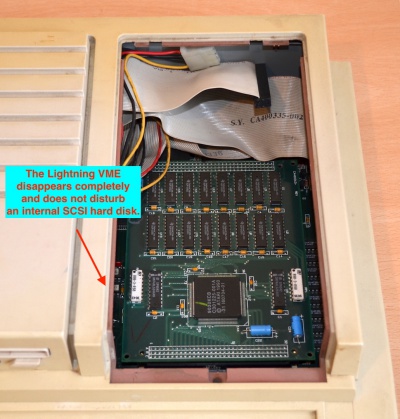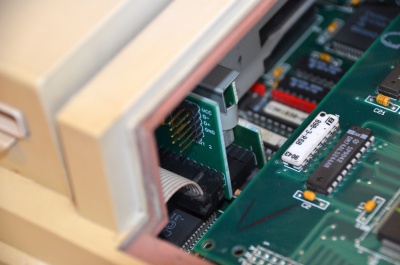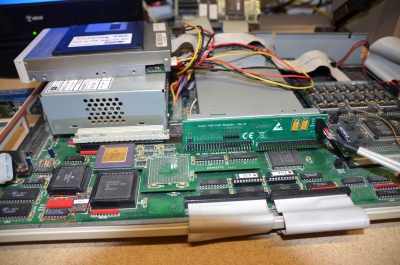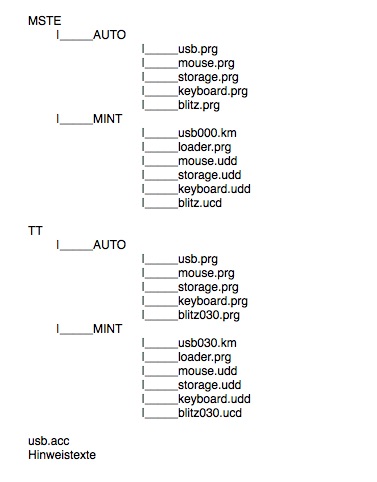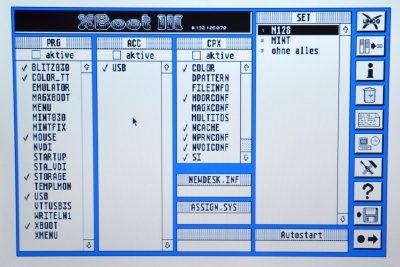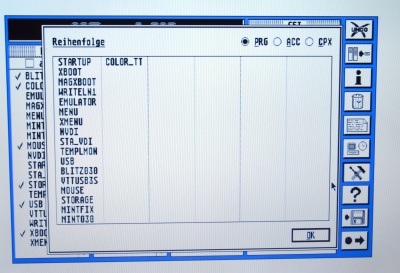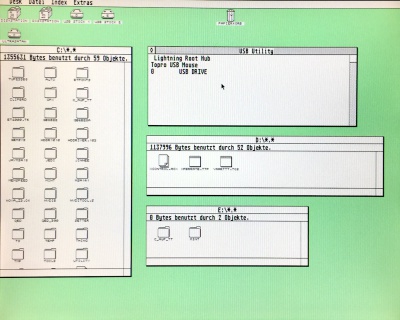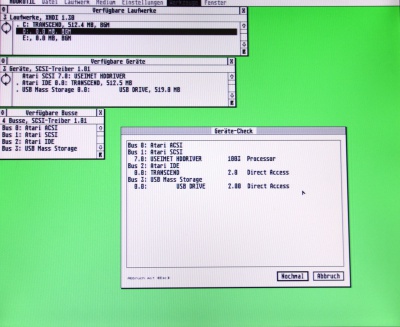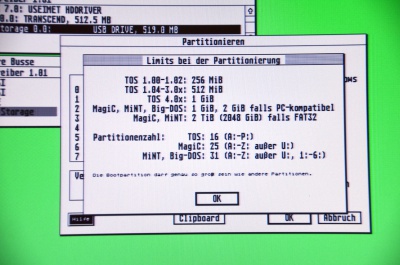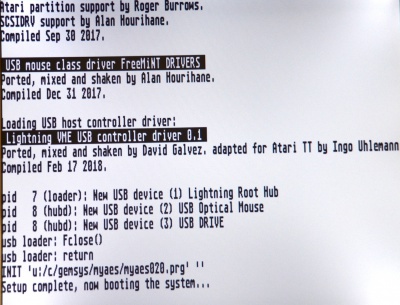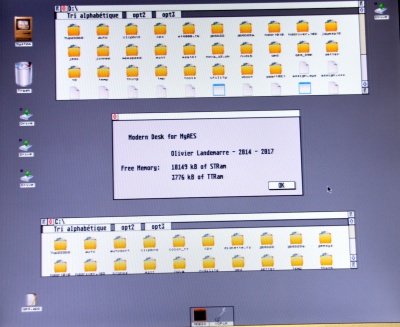Lightning VME En: Unterschied zwischen den Versionen
Gaga (Diskussion | Beiträge) |
Gaga (Diskussion | Beiträge) |
||
| Zeile 151: | Zeile 151: | ||
Then gently and evenly press the Lightning VME against the backplane with moderate force. | Then gently and evenly press the Lightning VME against the backplane with moderate force. | ||
Remember: may force be with you, young padawan! | |||
Version vom 6. März 2018, 22:44 Uhr
General
The Lightning VME is an internal plug-in card that extends the Atari TT and the Mega STE with two USB 1.1 compatible interfaces.
Features
- new developed in 2018 (Pakman, Tuxie, Czietz, Gaga)
- two USB 1.1 interfaces, expandable by USB-hub
- both ports can be used simultaneously
- no external power supply necessary
- even USB 2.0 devices work, but then at a reduced speed
- currently ca. 600kb/s transfer rate in unaccelerated TT
- also works in accelerated TT, thus further increase in performance (tested with 20MHz bus and 40MHz CPU)
- Transferrate is customizable
- compact design, fits in the original case of both the MegaSTE and the TT
- plug and play - fully pluggable solution
- central elements are a programmable Logic Device (CPLD) from Xilinx and the ISP1160 USB-Host-Controller from Philips
- handmade, SMD in reflow process
- triple protection of both USB ports:
- electrostatic discharge (ESD) protection when connecting external devices
- overcurrent protection by self-healing fuses
- secured against twisting the USB bracket by coding and labeling
- other interfaces, ROM port, ACSI interface and VME slot remain free
- support real USB mice, not only with PS/2 protocol
- finally true support of mass storage even under TOS
- works under TOS 2.06 and 3.06, Magic 5.x and Mint
- only occupies the address range 0xFEFF8000 - 0xFEFF8009 of the VME bus in the TT
- especially suitable in combination with Thunder IDE Interface and / or Storm
Description
The Lightning is designed so that no soldering is required; it´s is plug and play.
It disappears completely inside the original case.
Currently drivers for mass storage, mice and USB2LAN devices are available. Extensions by new drivers are possible, e.g. USB keyboard or USB floppy.
Now it´s possible to use:
- USB mice
- USB memory sticks
- USB card readers (SD, CF etc.)
- USB2LAN (with Asix 88772 chipset)
- USB CD / DVD drive (note current limitation and installation of ExtenDOS / MetaDOS required)
- USB keyboard (in planning)
- etc.
This finally enables the use of up-to-date hardware as well as the simplest data exchange in the world of Windows or OSX.
Hardwarerevisions and Firmware
As of 17.02.2018, the hardware revisions B with firmware 04 are up to date.
Hardware installation
The installation of the Lightning VME in the TT is very easy. Please follow the instructions below.
The card fits in all 3 known motherboard versions of the TT:
- Daughterboard - CPU (plugged)
- PGA CPU (plugged)
- SMD CPU (soldered on) - this version is particularly well suited for easy installation.
The Lightning VME harmonized well with the Thunder IDE Interface and the Storm. The cards are not hindering each other.
There is a small possibility that after installation of the Lightning VME your existing TT-RAM extension does not physically fit into the TT.
This applies, for example, to the original FAST RAM extension card from Atari (1/4/16 MB).
Then it's time to swap them for a [Storm] (up to 256 MB).
Delivery.
The computer in the closed state, here a little bit yellowed version.
Do not forget: all works without electricity!
After loosening the screws on the underside, carefully fold up the upper shell.
Carefully remove the two front ribbon cables from the backplane of the VME board.
The VME backplane is held by the metal cage.
It is not mandatory to remove the metal cage and / or the backplane.
View after opening the TT, looking at the VME backplane and the VME metal cage.
Here are the ribbon cables removed. That's half done!
Here is a close-up.
It is a TT with SMD CPU.
There is a lot of space for the installation of the Lightning.
The cabling is factory patches from Atari.
Soldering to install the Lightning VME is not required.
Another close-up. The TT is ready to plug in the Lightning VME now.
Gently bring the Lightning VME to the backplane. Page and direction are self-explanatory.
If you are sitting in front of the TT, you should be able to read on the top left "Atari VME-USB Adapter Rev. B" and the CE sign and two yellow, angular components.
Ensure correct position! No backplane pins should be visible.
Then gently and evenly press the Lightning VME against the backplane with moderate force.
Remember: may force be with you, young padawan!
By the way: please do not use the now visible, angled pins, do not connect either, otherwise there is a risk of damage.
The pins are exclusively for service (uploading the firmware).
That is exactly how it should look.
The TT now has 2 USB ports on the right side towards the internal hard drive / ST-RAM.
Seen from left and right.
Here you can see that the Lightning VME is parallel to the VME backplane, but without touching it at the top.
Closeup of the USB pins, divided into port 1 and 2.
There is no pen on the bottom left - this is the encoding for the USB bracket.
Plug of the USB bracket.
Nice to look at, right?
Here with closed top, but missing the so called "lunch box".
The bracket can be installed as desired, e.g. to the rear.
How about connecting a Teac FD-CR7 internally to one of the USB ports?
Of course, the lunch box fits on it again, even with a hard drive.
Custom work.
The picture shows the Lightning VME in a Daughterboard TT.
When everything is installed and screwed together, only the software has to be installed.
Installation der Software
Auf der beiliegenden Diskette befindet sich die Treibersoftware für TOS/Magic und Mint sowie eine Anleitung in Textform.
Sie ist aufgeteilt für Atari TT und Atari Mega STE wie folgt:
Achtung: nicht vertauschen, TT Treiber laufen nicht im MSTE und MSTE Treiber nicht im TT.
Beschreibung der Funktionsweise
loader.prg (nur für Mint)
Der Loader ist ein Hilfsprogramm welches den USB-Stack lädt und ins System einbindet
usb.prg / usbxxx.km
Bei dieser Datei handelt es sich um den USB-Stack, der USB am Atari überhaupt erst möglich macht.
Der USB Stack verwaltet den USB-Bus und die daran angeschlossenen Geräte.
Er stellt den folgenden Treibern die nötigen Grundfunktionen bereit.
blitz0x0.prg / blitzxxx.ucd
Diese Datei stellt das Bindeglied zwischen USB-Stack und der Lightning VME her.
Sie ermöglicht die Kommunikation zwischen dem USB-Stack und der Lightning VME Karte.
storage.prg und mouse.prg / storage.udd und mouse.udd
Diese Treiber setzen auf den USB-Stack auf und kommunizieren mit den angeschlossenen Geräten, wie einem USB-Stick (storage) oder einer USB-Maus (mouse).
Diese Treiber lassen sich beliebig erweitern ja nach Verfügbarkeit.
So können hier auch noch eth.prg (bereits existent) oder auch ein keyboard.prg (geplant) die Möglichkeit eines Netzwerkinterfaces und einer USB-Tastatur zur Verfügung stellen.
usb.acc
Dieses ACC sorgt unter TOS und Magic dafür, dass der USB-Bus hotplug fähig ist.
Es erkennt also, ob neue Geräte angesteckt worden sind und bindet sie ins System ein.
Es zeigt natürlich auch an welche Geräte aktuell angesteckt sind.
ergänzender Hinweis zu ExtenDOS/MetaDOS im Falle der Nutzung eines USB-CD-Laufwerks:
Dieses muss unbedingt nach storage.prg geladen werden.
Der USB-Treiber stellt einen Schnittstelle nach dem SCSIDRV-Standard bereit, die mittels ExtenDOS direkt genutzt werden kann.
Im Falle von MetaDOS ist ein Treiber wie z.B. SPIN von Julian F. Reschke nötig.
TOS und Magic
Hier wird der Inhalt des Auto-Ordners der Diskette einfach in den Auto-Ordner des Bootlaufwerks kopiert.
Achtung: die richtige Reihenfolge beim Kopieren bzw. beim Booten ist elementar wichtig!
Folgende Startreihenfolge ist unter TOS:
- USB.PRG
- BLITZ030.PRG
- MOUSE.PRG
- STORAGE.PRG
Im Fall der Benutzung von Magic ist Magic vor den USB Programmen zu laden:
- MAGXBOOT.PRG
- USB.PRG
- BLITZ030.PRG
- MOUSE.PRG
- STORAGE.PRG
Für TOS und Magic gilt gemeinsam:
- Ein eventueller Bootloader steht stets an erster Stelle.
- Eventuelle Grafikkartentreiber / NVDI sollte vor den USB Programmen geladen werden.
- Eventuelle weitere, optionale USB Gerätetreiber (ETH.PRG) kommen nach STORAGE.PRG
Hier ein Beispiel für eine funktionierende Reihenfolge:
Wenn alles korrekt funktioniert, sieht das unter TOS 3.06 dann so aus (hier mit Nova Mach32):
Man sieht, dass das USB.ACC die Lightning als Root Hub gefunden hat sowie eine optische USB Maus sowie einen USB Stick.
Vom System erkannte USB Massenspeicher (USB Drive) können wie gewohnt eingerichtet werden, hier am Beispiel des HHDriver 10.10.
Dabei gelten dieselben Restriktionen, wie für andere Laufwerke auch.
Mint
Die Installation unter Mint ist ebenfalls nicht schwer.
- Schritt 1:
Die Treiber werden hier nicht aus dem Auto-Ordner geladen, sondern über das loader.prg aus dem USB-Verzeichnis unter Mint.
Hierzu alle Dateien aus dem Verzeichnis a:\tt\mint von der Diskette kopieren nach
C:\mint\1-19-cur\usb
Sollte das USB Verzeichnis nicht existieren, muss dieses angelegt werden.
- Schritt 2:
Im nächsten Schritt muss die Datei mint.cnf, welche sich unter c:\mint\1-19-cur\ befindet, angepasst werden.
Dazu diese Datei mit einem Editor (z.B. QED, Luna etc.) öffnen.
Ziemlich am Ende der mint.cfg gibt es eine Zeile die sich wie folgt nennt:
GEM=u:/c/mint/1-19-CUR/xaaes/xaloader.prg
Vor dieser Zeile ist folgendes einzufügen
exec u:/c/mint/1-19-cur/usb/loader.prg
Wobei das CUR ggf. durch ihre vorhandene Kernelversionsnummer zu ersetzen ist.
Bei Starten von Mint sollte Driver etwa diese Ausgaben bringen.
Sodann stehen die USB Geräte auch unter Mint zur Verfügung, hier am Beispiel des MyAES Desktop.
Lightning VME im Zusammenspiel mit anderen VME Karten
Hinweis: die nachfolgenden Einträge werden laufend aktualisiert.
Grafikkarten
Folgende Grafikkarten funktionieren ohne Änderungen zusammen mit der Lightning VME:
- Matrix M128
- ...
Bei folgenden Grafikkarten sind Änderungen für das Zusammenspiel mit der Lightning VME erforderlich:
- Nova ET4000 und Mach32 - neues GAL für Nova, Jumper auf Stellung ..., Drahtverbindung auf der Nova zwischen Pin ... des GAL und PIN ... des VME Steckers
- ...
Netzwerkkarten
Folgende Netzwerkkarten funktionieren ohne Änderungen zusammen mit der Lightning VME:
- ...
letztes Update: 06.03.2018 (Gaga)
